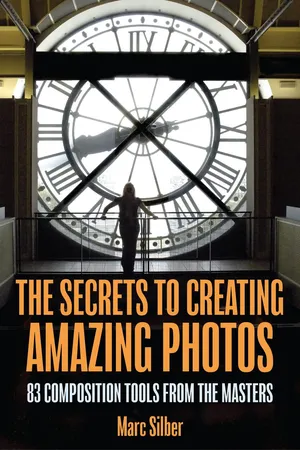
The Secrets to Creating Amazing Photos
83 Composition Tools from the Masters (Photography Book)
- English
- ePUB (mobile friendly)
- Available on iOS & Android
The Secrets to Creating Amazing Photos
83 Composition Tools from the Masters (Photography Book)
About this book
#1 Amazon New Release
HOW TO COMPOSE PHOTOS THAT DON’T SUCK
The Secrets to Creating Amazing Photos by Marc Silber is your complete, easy-to-follow guide to mastering composition — the most important skill in photography. Whether you’re shooting with a DSLR, mirrorless, or smartphone camera, this book gives you 83 proven tools from the masters to instantly improve your photos and creative confidence.
Learn the Secrets of Composition
There’s a common misconception that composition is mysterious or something only a few people are “born with.” The truth is that composition is a set of learnable tools — and once you understand how they work, you can use them to create stunning images every time. Just like cooking from a recipe, these techniques are easy to follow and deliver consistent, beautiful results.
Inside You’ll Discover:
- 83 composition tools you can use right away to transform your photography.
- Easy-to-follow visual “recipes” based on the techniques of legendary photographers and artists.
- How to see light, balance, and framing differently — and use them to tell powerful stories.
- Step-by-step examples that show you how small adjustments make a big impact.
- How to develop your creative eye and train your instincts through practice and observation.
- Bonus online resources: Exclusive access to companion videos and downloadable guides to reinforce what you learn.
Why This Book Works
Marc Silber has spent decades studying and interviewing world-class photographers — uncovering the composition tools and habits that make their images stand out. He’s condensed this wisdom into a clear, practical handbook that anyone can use. Each “recipe” explains what to look for, how to apply it, and why it works — so you can build creative confidence with every shot.
Carry It Anywhere
Designed to fit easily in your camera bag, this book is your portable composition coach. Use it on location for quick inspiration, try new techniques on the spot, and record your progress as your photos improve. Whether at home or in the field, you’ll always have expert guidance at your fingertips.
Key Benefits:
- Take better photos instantly by mastering the keys to composition.
- Gain quick, practical “recipes” for framing, balance, and light.
- Learn creative tools used by the world’s best photographers.
- Build confidence, purpose, and visual storytelling skills.
- Transform snapshots into photographs you’re proud to share.
What Photographers Say:
“This is a wonderful book on composition… Marc lays them out in depth.” — J. Ann Ryan, Amazon Verified Purchase
“Bright, helpful photography teaching that will improve anyone at any level.” — J. Ann Ryan, Amazon Verified Purchase
“The Secrets to Creating Amazing Photos is so easy to use.” — Dr. Nicholas Larsen, Amazon Verified Purchase
“Valuable book for creating powerful photographic images.” — B. Phil Shoop, Amazon Verified Purchase
“The author lays out many recipes for composition in a way that is simple and easy to understand.” — Beth Miller, Amazon Verified Purchase
Take your photography to the next level — learn to see like the masters, shoot with intention, and create photographs that truly connect.
Keywords:
composition · photography tips · visual design · lighting · framing · storytelling · beginner photography · creative photography guide · learn composition · photo techniques
Frequently asked questions
- Essential is ideal for learners and professionals who enjoy exploring a wide range of subjects. Access the Essential Library with 800,000+ trusted titles and best-sellers across business, personal growth, and the humanities. Includes unlimited reading time and Standard Read Aloud voice.
- Complete: Perfect for advanced learners and researchers needing full, unrestricted access. Unlock 1.4M+ books across hundreds of subjects, including academic and specialized titles. The Complete Plan also includes advanced features like Premium Read Aloud and Research Assistant.
Please note we cannot support devices running on iOS 13 and Android 7 or earlier. Learn more about using the app.
Information
FUNDAMENTAL COMPOSITION GUIDES AND TOOLS
of your subject matter within the confines
of your picture space.”
of usual camera or smartphone (you’ll see many of my photos
in the book were taken with an iPhone which I noted in the caption.) Almost all cameras produce a rectangular image, but a few are square.





Table of contents
- Cover
- Title Page
- Copyright
- Table of Contents
- Foreword
- Preface
- How to Use This Book to Create Amazing Photos
- Acknowledgements
- Part One: Fundamental Composition Guides and Tools
- Part Two: Composition Lines that Convey Moods in your Image: Mood Lines Convey Feelings or States of Mind
- Part Three: Putting your Tools Together and Final Tips
- Endnotes
- About the Author